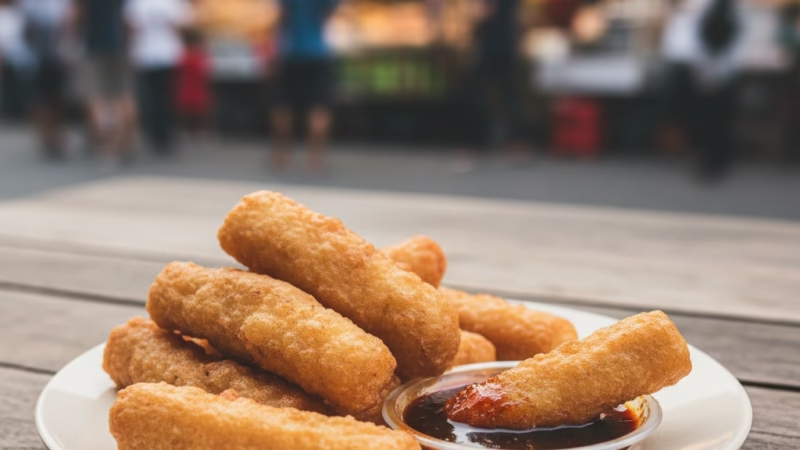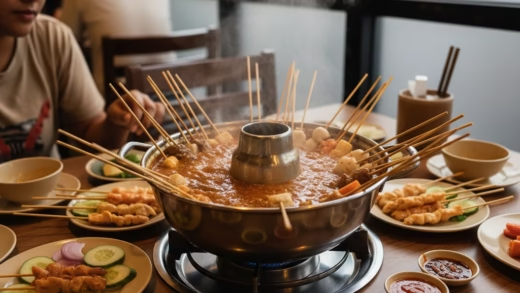Keropok Lekor

Malaysian Food
Keropok Lekor
Origin
East Coast of Peninsular Malaysia, especially Terengganu.
Category
Traditional snack / street food.
Appearance
Long, sausage-like rolls, either chewy and boiled or golden brown and crispy after frying. Thinly sliced versions resemble crunchy chips.
Ingredients
- Fresh fish (mackerel, sardine, wolf herring)
- Sago flour or tapioca starch
- Salt
- Water
- Optional: garlic, sugar, or seasoning
Preparation
- Blend deboned fish into a paste.
- Mix with flour and seasoning into dough.
- Roll into cylindrical shapes.
- Boil until they float (keropok lekor rebus).
- Optionally slice and deep-fry until golden brown (keropok lekor goreng).
Equipment
- Blender / mortar & pestle
- Mixing bowl
- Large pot (boiling)
- Wok/pan (frying)
- Strainer
Variations
- Keropok Lekor Rebus – boiled, chewy.
- Keropok Lekor Goreng – fried, crispy outside, soft inside.
- Keropok Keping – thin, dried, and fried into crunchy chips.
- Modern twists with cheese, spicy seasoning, or fusion dips.
Taste
Savory, salty, and fishy with mild sweetness.
Texture
- Soft and chewy (boiled).
- Crispy outside, chewy inside (fried).
- Crunchy (chip version).
Aroma
Distinct fish aroma, intensified when fried.
Sound
Crisp crunch when bitten (fried/chip), soft chewiness for boiled version.
Cultural Significance
A staple East Coast Malaysian snack, deeply tied to fishing communities. Often eaten as an affordable comfort food nationwide.
Symbolism
Represents the resourcefulness of coastal communities in turning abundant fish into a preserved and beloved delicacy.
Regional Cuisine
Widely enjoyed in Malaysia, especially Terengganu and Kelantan. Exported as frozen snacks to nearby countries.
Social Context
Sold at roadside stalls, pasar malam (night markets), and beaches. Commonly eaten with chili sauce during tea time or after school.
Nutritional Information (per ~100g fried)
- Calories: ~250 kcal
- Protein: 8–10 g
- Carbohydrates: 30 g
- Fat: 10–12 g
Health Benefits
- Provides protein and omega-3 from fish.
- Source of energy from starch.
Dietary Restrictions
- Not suitable for vegetarians or vegans.
- Generally halal if prepared with standard ingredients.
Allergens
- Fish
- Possible gluten (if wheat flour added)
- Risk of cross-contamination from frying oil in hawker stalls.
Cost
Very affordable: RM1–RM5 depending on portion and location.
Production
Homemade by coastal communities, now mass-produced and sold frozen in markets and supermarkets.
Sustainability
Dependent on fish availability—sustainable fishing practices are important to maintain tradition.
Availability
Abundant in Terengganu and Kelantan, but also sold across Malaysia. Frozen versions are available internationally.
History
Developed centuries ago as a way to preserve fish harvests. Mixing fish with starch extended shelf life and reduced waste. Over time, it evolved into Malaysia’s iconic snack.
Anecdotes
- Terengganu locals say no visit is complete without keropok lekor.
- Many Malaysians recall buying it hot and fresh after school for a few coins.
How to Prepare
- Blend 500g fish flesh with salt.
- Add 200g sago flour, mix into dough.
- Roll into long cylinders.
- Boil until floating.
- Serve boiled or slice and deep-fry.
- Dip in chili sauce and enjoy.
FAQ
Q: Is keropok lekor always fried?
A: No, it can also be boiled.
Q: What’s the best dip?
A: Spicy-sweet chili sauce.
Q: Can I freeze it?
A: Yes, boiled keropok lekor can be frozen and fried later.
Q: Why are some chewy and others crispy?
A: Texture depends on preparation (boiled vs fried) and ratio of fish to flour.








Comments are closed.